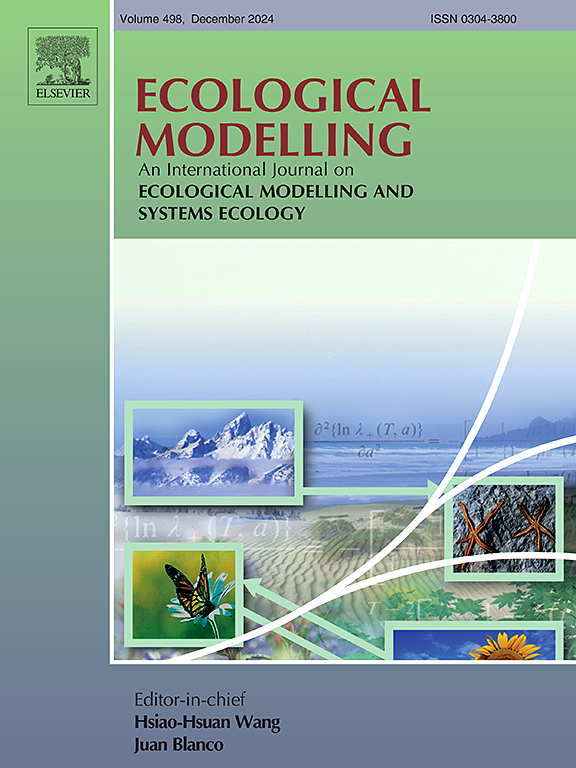Complementing single-species assessment models with age- and time-varying natural mortality: Insights from holistic ecosystem models
IF 3.2
3区 环境科学与生态学
Q2 ECOLOGY
引用次数: 0
Abstract
Integrating information on ecosystem dynamics into single-species stock assessment has been recommended for fisheries management to head towards Ecosystem-Approach to Fisheries Management (EAFM). This paper proposes a sensitivity analysis of single-species assessments in relation to the implementation of time-varying natural mortality (M). Time-varying estimates from a holistic ecosystem model were implemented in exploratory Celtic Sea gadoid stock assessments. Two species were selected to disclose different temporal patterns in M: whiting (Merlangius merlangus) displaying a trend and haddock (Melanogrammus aeglefinus) exhibiting high variability with no trend. Implementing overall higher M levels increases Spawning Stock Biomass (SSB) and decreases average fishing mortality at age (Fbar) in both cases. Here, time-varying values induce reference points modification. Introducing a trend in M improves the assessment quality for whiting, while shifting the stock status from fully exploited to overexploited for several years. Integrating high M variability for haddock induces minimal changes in assessment quality and stock status. In both cases, short term projected sustainable catch level was reduced by 14%. Despite uncertainty around estimates, results suggest that integrating M accounting for a varying predation is crucial, especially when M disclose a trend. Future research should focus on comparing M estimates across various sources, including ecosystem models, and benchmarking the single-species models’ sensitivity to time-varying values.
用年龄和时间变化的自然死亡率补充单物种评估模型:来自整体生态系统模型的见解
已建议将生态系统动态信息纳入单一物种种群评估,以便渔业管理朝着生态系统方法渔业管理(EAFM)的方向发展。本文提出了单物种评估与时变自然死亡率(M)实施的敏感性分析。从整体生态系统模型的时变估计在探索性凯尔特海gadoid种群评估中实施。选择两个物种揭示了M的不同时间模式:白鲑(Merlangius merlangus)表现出趋势,黑线鳕(Melanogrammus aeglefinus)表现出无趋势的高变异性。在这两种情况下,实施总体较高的M水平增加了产卵种群生物量(SSB)并降低了平均年龄捕捞死亡率(Fbar)。这里,时变值引起参考点修改。在M中引入趋势可以提高白鲑的评估质量,同时将种群状态从充分开发转变为过度开发。整合黑线鳕的高M变异性导致评估质量和种群状况的最小变化。在这两种情况下,短期预计可持续捕获量减少了14%。尽管估计存在不确定性,但结果表明,整合M对不同捕食行为的解释至关重要,尤其是当M揭示了一种趋势时。未来的研究应侧重于比较不同来源(包括生态系统模型)的M估计,并对单物种模型对时变值的敏感性进行基准测试。
本文章由计算机程序翻译,如有差异,请以英文原文为准。
求助全文
约1分钟内获得全文
求助全文
来源期刊

Ecological Modelling
环境科学-生态学
CiteScore
5.60
自引率
6.50%
发文量
259
审稿时长
69 days
期刊介绍:
The journal is concerned with the use of mathematical models and systems analysis for the description of ecological processes and for the sustainable management of resources. Human activity and well-being are dependent on and integrated with the functioning of ecosystems and the services they provide. We aim to understand these basic ecosystem functions using mathematical and conceptual modelling, systems analysis, thermodynamics, computer simulations, and ecological theory. This leads to a preference for process-based models embedded in theory with explicit causative agents as opposed to strictly statistical or correlative descriptions. These modelling methods can be applied to a wide spectrum of issues ranging from basic ecology to human ecology to socio-ecological systems. The journal welcomes research articles, short communications, review articles, letters to the editor, book reviews, and other communications. The journal also supports the activities of the [International Society of Ecological Modelling (ISEM)](http://www.isemna.org/).
 求助内容:
求助内容: 应助结果提醒方式:
应助结果提醒方式:


